Right now, there are over 1,000 UNESCO World Heritage Sites spread across 170 countries around the world, and each one has a story to tell. Some are ancient cities carved into desert cliffs. Others are wild landscapes where nature still sets the pace. Together, they form a living record of both human creativity and the wonder of our natural world.
When you’re living abroad, these places can feel like a bridge back to your heritage, a spark of pride in your roots, or simply an invitation to explore cultures that are new to you. At Remitly, we understand that the immigrant journey is about balancing connection and discovery, and World Heritage Sites are a powerful reminder that we all share in something bigger: a global story.
In this guide, we’ll take you through eight remarkable UNESCO World Heritage Sites so you can start building a bucket list that’s not only inspiring but also meaningful.
What makes a UNESCO World Heritage Site special
Before we get into the list, you might be wondering what makes these places stand out, and why they’re so important for travellers, locals, and future generations alike.
The meaning behind the designation
UNESCO (the United Nations Educational, Scientific and Cultural Organisation) awards World Heritage status to sites of “outstanding universal value”. This means that their significance reaches beyond one nation and belongs to everyone. This recognition can apply to:
- Cultural sites, such as temples, ancient cities, or historic centres.
- Natural sites, like mountain ranges, forests, or coral reefs.
- Mixed sites, which combine both cultural and natural value.
Being listed not only celebrates a site’s importance but also comes with international support and funding for preservation. That’s why places like Machu Picchu or the Galápagos aren’t just tourist destinations; they’re safeguarded for posterity.
Why these sites matter for immigrants
For immigrants, UNESCO World Heritage Sites can be especially meaningful. They may offer a tangible link back to your home country or provide a way to discover the heritage of your new community.
Visiting these places can feel like stepping into a story that connects your personal journey with the wider world, a reminder that culture and nature belong to us all, no matter where we live—or where we’ve come from.
How sites are chosen
Each country nominates potential sites, and experts evaluate them based on strict criteria.
A committee then decides if they’re worthy of the World Heritage List. The process is rigorous because the goal is not just recognition, but protection, ensuring these treasures survive political changes, environmental threats, and the pressures of tourism.
So, here are eight that we think are unmissable, at least at some point in your life, if you’re able.
Angkor Wat, Cambodia: where ancient empires come to life
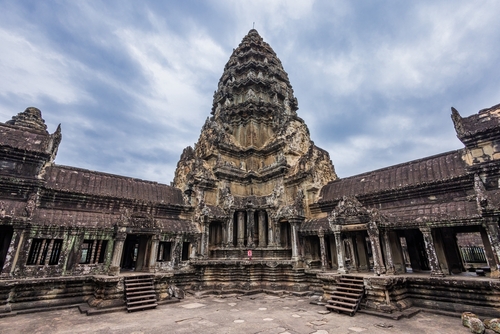
Few places capture the imagination quite like Angkor Wat. Walking through its stone corridors feels like stepping back into another world.
The world’s largest religious monument
Built in the 12th century by the Khmer Empire, Angkor Wat is the largest religious monument on Earth. Covering over 400 acres, its towers, galleries, and carvings make it a cultural icon. For many Southeast Asian immigrants in the UK, it’s also a powerful link to ancestral history and identity.
Sunrise and stone carvings: what makes it magical
Ask anyone who’s been, and they’ll tell you: sunrise is the time to see Angkor Wat. As the first light reflects off lotus-shaped towers and ripples across the pools, the temple seems to glow. The walls are alive with carvings of gods, battles, and celestial dancers, created by artisans nearly 900 years ago.
Tips for planning your visit
Making the most of Angkor Wat takes a little planning, but it’s worth it.
- Best time to go: November to March, during Cambodia’s dry season.
- Tickets: Available for one, three, or seven days; most travellers recommend at least two to three days.
- Budget tip: Tuk-tuks are affordable and give you the freedom to explore.
- Guides: Hiring a local guide adds real depth and helps support the community.
Cultural extras near Angkor
In nearby Siem Reap, a buzzing night market serves Cambodian favourites like amok curry and grilled skewers. For first-time visitors in particular, they’re a delicious way to experience local culture.
Conservation and preservation efforts
With millions of visitors each year, Angkor Wat faces pressure on its fragile stonework. Preservation projects are ongoing, but travellers play their part too, like sticking to marked paths, avoiding contact with carvings, and respecting the site’s spiritual importance.
Galápagos Islands, Ecuador: Darwin’s living laboratory
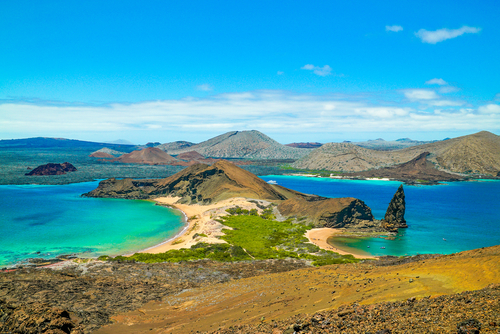
A trip to the Galápagos feels less like a holiday and more like stepping into nature’s classroom. Every island, every bird, every iguana has a lesson to teach about survival and adaptation.
Why the Galápagos inspired evolution theory
When Charles Darwin visited in 1835, he noticed animals varied dramatically from island to island. These observations helped shape his theory of evolution, one of the most influential ideas in science.
Wildlife you won’t see anywhere else
The Galápagos brim with biodiversity. Giant tortoises lumber across the landscape, while blue-footed boobies show off their comical dances. In the water, you might snorkel alongside playful sea lions or marine iguanas grazing on algae.
But the islands aren’t just about wildlife. Small Ecuadorian communities live here too, and sharing fresh ceviche or locally grown coffee adds another dimension to the experience. For Latin American immigrants in the UK, the Galápagos can feel both like a homecoming and a celebration of a heritage the world treasures.
How to visit responsibly
The ecosystem of the Galápagos is fragile, so responsible travel matters. Try to stick to designated trails, avoid touching wildlife, use reef-safe sunscreen, and choose eco-certified operators who contribute to conservation efforts if you can.
Choosing between cruises and land tours
There are two main ways to see the Galápagos. Cruises reach remote islands and cover more ground, while land-based tours are more budget-friendly and let you stay in local guesthouses. Whichever you choose, it’s a good idea to book early as permits are limited and sell out quickly.
Petra, Jordan: the rose city carved in stone
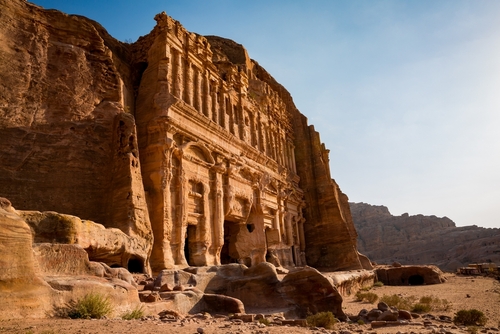
Few travel experiences compare to walking through a narrow canyon and seeing the Treasury of Petra appear in front of you, glowing pink in the desert sun.
Walking through the Siq to the Treasury
The entrance to Petra is as dramatic as the city itself. The Siq, a winding, high-walled canyon, opens out suddenly onto Al-Khazneh, the Treasury—one of the most photographed monuments in the world.
Life in the desert: Nabataean water systems
The Nabataeans built an advanced water management system that allowed them to thrive in the desert, channelling rainwater into cisterns and reservoirs. It’s a testament to human ingenuity in harsh environments.
Petra in film and popular culture
For many, Petra feels familiar before they even arrive. It’s been immortalised in films like “Indiana Jones and the Last Crusade”, making it one of the most recognisable World Heritage Sites.
Yellowstone National Park, USA: the world’s first national park
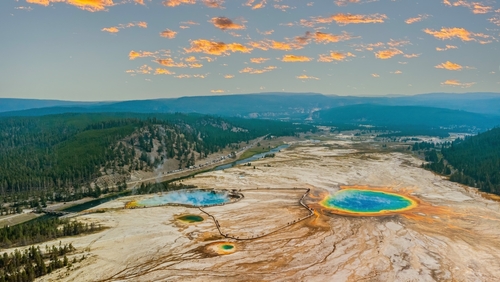
Yellowstone isn’t just a park; it’s the place that started the entire concept of national parks worldwide.
A landscape of geysers and hot springs
From the reliable eruptions of Old Faithful to the rainbow-coloured waters of the Grand Prismatic Spring, Yellowstone’s geothermal wonders are unlike anywhere else on Earth.
The park is also home to a rich variety of wildlife. Bison roam freely, wolves have been successfully reintroduced, and grizzly bears still roam its forests. If you visit, remember this and regard the wildlife with respectful caution.
Best times to visit Yellowstone
Summer brings crowds but also accessible trails. Winter offers a quieter experience with snow-covered landscapes, though you’ll need to bundle up. With so much wildlife and geothermal activity, it’s vital to stay on trails and follow safety rules. Like the Galápagos, Yellowstone’s beauty is fragile, and your choices help protect it.
Why Yellowstone matters for global conservation
When it was established in 1872, Yellowstone became the world’s first national park. That decision sparked a movement that inspired protected areas around the globe, including the UK’s own Lake District.
Machu Picchu, Peru: the lost city of the Incas
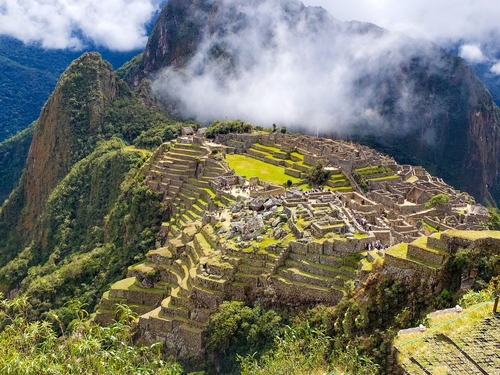
High in the Andes, Machu Picchu seems to float among the clouds, its stone terraces and temples perched dramatically on a mountain ridge.
A mountain-top mystery
Rediscovered—at least to the Western world—in 1911, Machu Picchu’s true purpose is still debated. Was it a royal retreat, a spiritual site, or something else entirely? Its mystery only adds to its magic.
The city’s construction is just as impressive: the Incas built it at around 2,400 metres above sea level, using precise stonework that has survived centuries of earthquakes and storms.
Trekking routes and permits
A lot of travellers arrive via the famous Inca Trail, though quieter alternatives like the Salkantay Route are just as rewarding.Keep in mind that visitor numbers are capped, so remember to book permits months in advance.
Before or after your trek, you could spend time in Cusco, where dishes like ceviche or lomo saltado showcase Peru’s culinary heritage. In fact it’s a good idea to pause for a while there—or better still at Sacred Valley, which is lower down—as part of the process of acclimatising to the lower oxygen levels at such altitudes.
Preserving Machu Picchu for the future
With its global popularity, Machu Picchu faces conservation challenges. Strict limits on visitor numbers are now in place, and respecting these rules helps protect the site for future generations. Travelling mindfully helps ensure that its magic endures.
Great Wall of China: the world’s longest fortification
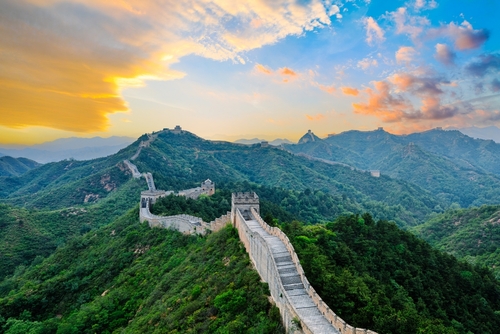
Stretching over 13,000 miles, the Great Wall of China is a symbol of endurance, ingenuity, and cultural identity.
History, myths, and meaning
Built across centuries and dynasties, the Wall isn’t one continuous line but a network of fortifications winding across mountains, valleys, and deserts.
Originally made for defence, it also helped regulate trade and communication, leaving a legacy that still plays a part in defining China’s cultural identity today. One common myth claims it’s visible from space, but that’s not true. What is true is just as remarkable: it remains one of the largest human-made structures in history.
Exploring the Wall today
Different sections of the Wall offer different experiences. Mutianyu is well restored and easier for most travellers, while Jinshanling provides a wilder, more rugged feel. Visiting early in the morning helps you avoid the biggest crowds and take in the scale of the Wall in relative peace.
Serengeti National Park, Tanzania: witness the great migration
The Serengeti is where nature stages one of its greatest spectacles: the annual movement of millions of animals across its endless plains.
The great migration and life on the plains
Each year, over 1.5 million wildebeest and hundreds of thousands of zebras thunder across the grasslands in search of fresh grazing.
Where the herds go, predators follow. Lions stalk and crocodiles wait at river crossings, turning the migration into a dramatic struggle for survival. It’s a powerful demonstration of how finely balanced ecosystems are.
Safaris, culture, and travelling responsibly
The Serengeti is also home to the Maasai people, whose traditions remain deeply connected to the land. Meeting Maasai communities adds a cultural layer to the experience and shows that the Serengeti is about people as well as wildlife.
Safaris range from budget campsites to luxury lodges, and the best time to visit depends on which stage of the migration you want to see. Booking with eco-conscious operators ensures your trip supports conservation and local communities, helping the Serengeti thrive for generations to come.
Mont-Saint-Michel, France: a medieval marvel rising from the sea
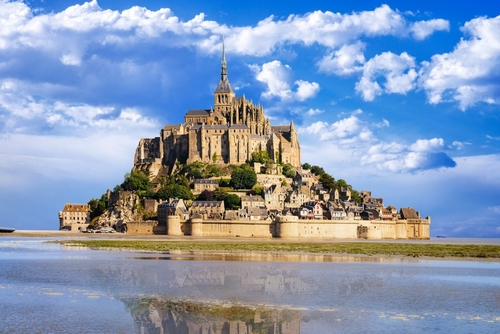
Just a short trip from the UK, Mont-Saint-Michel in France rises dramatically from the sea, its spires and walls appearing to defy the tides.
A tidal island with centuries of history
What began as a Celtic sanctuary became a Christian pilgrimage site that has drawn visitors for over a thousand years. At its peak, pilgrims crossed treacherous sands to reach the island, making it as much a spiritual journey as a physical one.
The abbey, tides, and landscapes
The Gothic abbey crowning Mont-Saint-Michel is a feat of medieval engineering, perched on a rocky outcrop that has endured centuries of storms and sieges. Twice a day, the tides transform the island from a coastal village into a sea-locked fortress, one of the most dramatic natural backdrops in Europe.
Visiting Mont-Saint-Michel
To enjoy Mont-Saint-Michel, it’s essential to plan around the tides. If possible, stay overnight nearby. Mornings and evenings are a lot quieter, and while you’re there, try the island’s famous omelettes or sip local cider.
Start planning your UNESCO adventure today
Visiting a UNESCO World Heritage Site means stepping into humanity’s shared story. From Angkor Wat at sunrise to cider at Mont-Saint-Michel, these places connect us across borders and generations.
For immigrants in the UK, these sites can be a way to reconnect with roots or discover a new heritage. Not everybody’s going to be able to tick off all eight of these, of course, so consider starting with one site that particularly excites you and making that your first target—you may get the bug to see more. The world’s greatest cultural and historical stories are waiting.
FAQ
How are UNESCO World Heritage Sites chosen?
Sites are nominated by their home countries and evaluated by experts before the World Heritage Committee decides. They must meet strict criteria, whether cultural, natural, or mixed.
Do I need special permits to visit these sites?
Most sites are open to the public, though some require planning. Machu Picchu has limited permits, and the Galápagos enforces strict visitor controls. Remember to check before travelling.
How can I visit responsibly?
It’s recommended to follow Leave No Trace principles, hire local guides, and choose sustainable operators. Supporting local communities ensures your visit has a positive impact.
What’s the best time of year to visit multiple UNESCO sites?
It depends on the region. Dry seasons are best for sites like Angkor Wat and Serengeti, while summer brings accessibility in Yellowstone. If you’re UK-based, consider grouping trips by region to save on flights.